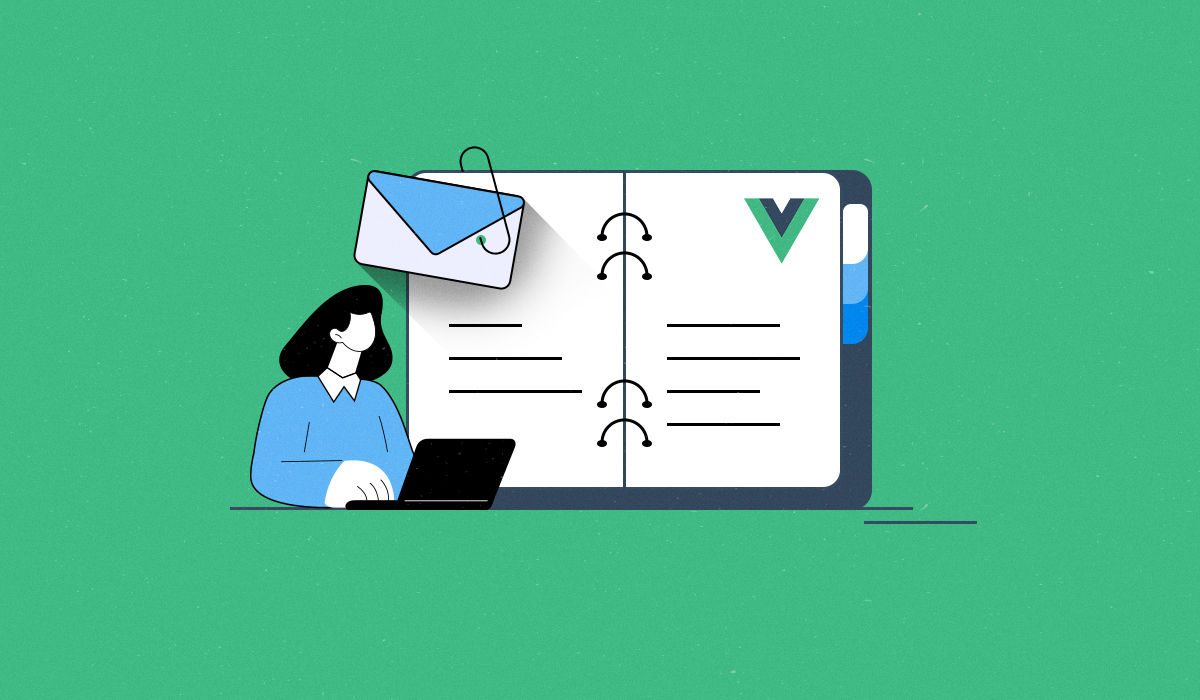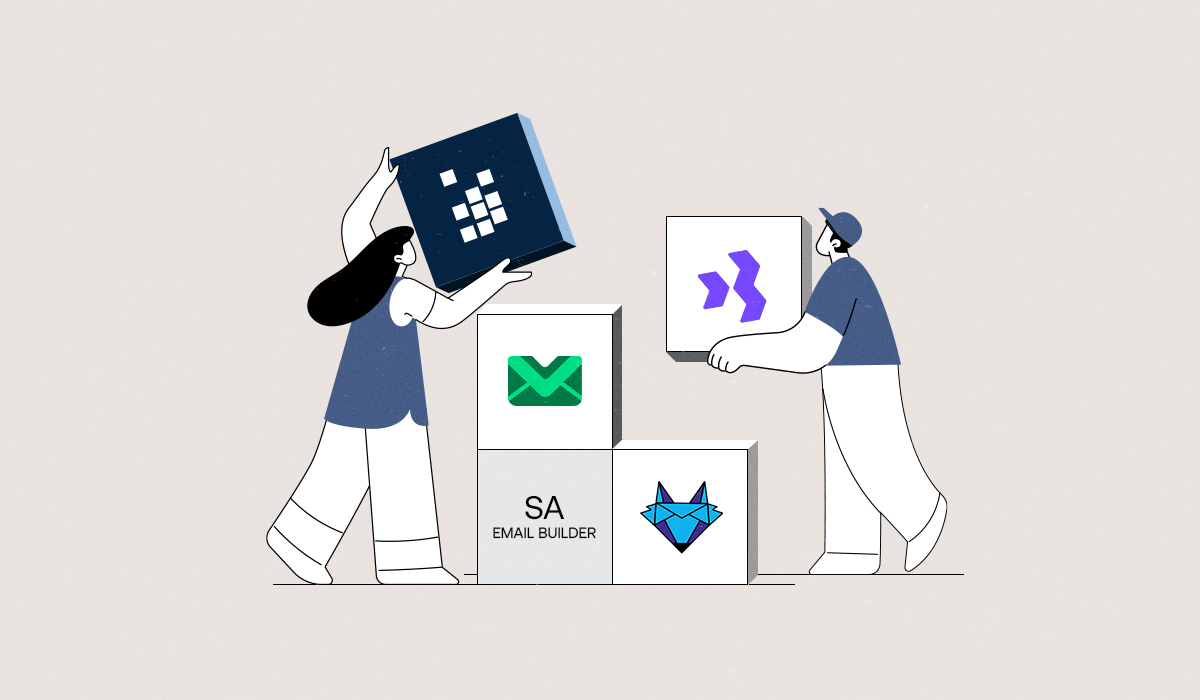Adding email-building functionality to your Vue app comes with a lot of questions—what to consider, which builder to pick, how to embed, and how to keep performance optimized.
And honestly, those questions are valid. You’re not just adding an editor but creating an experience where users can craft branded, responsive emails without leaving your platform. That means thinking about reusable components, reactive updates, and seamless integration with your existing Vue architecture — all without slowing down your app or breaking layouts.
This guide covers everything you need to know about Vue email builders:
What Is a Vue Email Builder and Why Use One?
Must-Have Features in a Vue Email Builder
Best Vue Email Builders (and What Makes Them Great)
How to Embed a Vue Email Builder in Your App
Optimizing Performance for Vue Email Builders
Common Unlayer Integration Issues in Vue (and Their Fixes)
FAQs Related to Vue Email Builder
What Is a Vue Email Builder and Why Use One?
A Vue email builder isn’t just a drag-and-drop editor — it’s a purpose-built tool that fits naturally into your Vue app.
For developers, it’s a massive time-saver. Instead of building a full editor from scratch — managing drag-and-drop logic, responsive layouts, content rendering, and cross-client compatibility — you can embed a pre-built Vue component that already handles all of it. That means faster development cycles, cleaner architecture, and fewer bugs.
And for end-users, it’s pure convenience. They can create professional, on-brand emails right inside your product, ensuring consistency and speed — no switching between tools or waiting on your dev team for layout tweaks.
In short, a Vue email builder gives your app a native, intuitive email design experience while saving your developers countless hours of effort.
Core Features to Look For in a Vue Email Builder
A top-notch Vue email builder isn’t just about dragging and dropping blocks—it’s about giving your users the tools to create professional, on-brand emails effortlessly while giving developers the flexibility to customize, extend, and optimize every aspect. The right features make email creation fast, consistent, and scalable.
Here are some of the core features you must consider before investing in any Vue email builder:

Drag-and-Drop Interface: Users should be able to visually create and rearrange content blocks without touching HTML or CSS.
Pre-Built & Customizable Blocks: Offer ready-to-use content blocks and give developers the flexibility to create custom, reusable blocks to ensure consistent branding and faster design workflows.
White-Labeling & Brand Customization: Let users apply logos, fonts, and colors while giving developers control to lock brand assets or limit design changes to maintain visual consistency.
Responsive & Cross-Client Compatibility: Emails should render perfectly across all devices and clients, including Gmail, Outlook, and Apple Mail.
Personalization: Support for dynamic content, including merge tags, conditional logic, and dynamic variables to help users build relevant, personalized emails directly within your Vue app.
Template Library & Management: A built-in template library, along with autosave, undo/redo, and version history, lets users create, reuse, and safely edit designs without losing work.
Developer-Friendly Integration & Extensibility: A Vue-compatible SDK or component with clean APIs for seamless integration. Developers should also be able to add custom tools, plugins, or UI extensions for advanced control.
Collaboration & Localization: Real-time collaboration, role-based access, and multi-language support make it ideal for global, team-based workflows.
Performance, Security, and Scalability: The builder should be lightweight, fast, and secure — optimized for Vue’s reactivity and ready to scale with your user base.
Unlayer checks all the boxes for you, offering every must-have feature so you do not have to compromise on flexibility, speed, and ease of use.
Check out: Unlayer’s Vue Email Builder: Must-Know Features + Quick Setup
Best Vue Email Builders (And What Makes Them Great)
When it comes to Vue email builders, developers often fall into two categories: those seeking open-source tools that they can fully customize, and those who prefer Vue.js libraries that integrate seamlessly into their projects with minimal setup.
Let’s explore both options — complete with quick comparisons and key insights — so you can pick the right fit for your app.
Top 5 open-source Vue email editors
Open-source editors give you full control over customization, licensing, and contribution. They’re perfect for developer teams who prefer flexibility over plug-and-play simplicity.
Here are five leading options worth exploring:
Tool | Type | Key Features | Pros | Cons | Ideal For | GitHub |
Unlayer Vue Email Editor | Drag-and-drop (official Vue wrapper) | Custom tools, dynamic content blocks, export (HTML/JSON), responsive design | - Powerful SDK - Highly customizable - Enterprise-friendly - Actively maintained | Branding in free version | Teams needing a production-ready, customizable visual editor | |
GrapesJS (with Vue wrapper) | Visual HTML editor (not native to Vue, but can be wrapped) | Email template builder plugin, MJML integration, modular system and extensible | - 100% free - Plugin-rich - Highly flexible | - No official Vue wrapper - Complex setup | Developers wanting flexible open-source control | |
vue-email-builder | Lightweight Vue-native editor | Drag-and-drop, responsive layout, basic preview | - Vue-native - Minimal setup - Lightweight | Limited features - Rare updates | Teams needing a simple Vue-native builder | |
MJML with Vue | Code-based (markup engine) | MJML components, responsive by default | - Developer-friendly - High deliverability | - No visual editor - Code-heavy | Dev teams preferring code-first, responsive design | |
vue-email | Code-based Vue component library | Vue-style syntax, server rendering, reusable components | - Developer-focused - Reusable components - Fully customizable | - No drag-and-drop UI - Requires build setup | Developers needing logic-driven, reusable templates |
Read the full breakdown on our blog: 5 Best Open-Source Vue Email Editors for Developers Compared.
Top 5 Vue.js email builder libraries
If you prefer a lighter, integration-focused approach, Vue.js email builder libraries are your go-to. They’re optimized for embedding, extendable through APIs, and often come with better documentation and support.
These libraries let you bring drag-and-drop or code-based email editing directly into your Vue app without building from scratch.
Library | Type | Key Features | Pros | Cons | Ideal For |
Unlayer Vue Email Editor | No-code (Embeddable SDK) | Drag-and-drop builder, white-label customization, reusable custom blocks, dynamic content, REST API, AI-powered features, 2000+ templates | Highly customizable, fast integration, 99.9% uptime SLA, cost-efficient (cuts dev cost by 52%), Enterprise-grade security | Premium features like white-labeling are available on the paid plans | SaaS teams & enterprises needing a fully embeddable, customizable solution |
Vue Email | Developer-first library | Build & render templates in Vue/TypeScript, Tailwind CSS support, 15+ pre-built components, Nuxt 3 compatible | Great for developers, clean TypeScript API, modern codebase | No visual builder, still experimental | Developers building coded email templates |
Beefree Vue Email Builder | No-code (Embeddable SDK) | Drag-and-drop editor, personalization, API suite, AI writing assistant, real-time collaboration | Easy to embed, strong customization, ready HTML templates | Expensive plans(starting at $350+/month), HTML cleanup needed for some ESPs | SaaS apps needing a visual, customizable builder |
SA Email Builder | Visual + Code Hybrid | Built with Vue + Quasar, supports MJML & JSON, live preview, built-in file uploads, undo/redo | MJML-based responsive emails, dual UI for devs and non-devs | Limited components, lacks collaboration, Limited documentation | SaaS teams needing an internal visual and code hybrid email builder |
Bluefox.email | All-in-one Email Platform | Pre-built templates, AWS SES support, Handlebars personalization, analytics & reporting | Full email stack (build + send + track), great analytics | No embeddable SDK, no white-labeling | Teams needing a hosted email solution rather than an embeddable builder |
For an in-depth comparison, check out Top 5 Vue.js Email Builder Libraries Developers Should Know.
How to Embed a Vue Email Builder in Your App
Embedding a Vue email builder into your app is simpler than you might think — especially if you’re using a plug-and-play SDK like Unlayer.
Here’s how:
Install the Vue Component: Add Unlayer’s official Vue wrapper using npm or yarn to quickly bring the email editor into your Vue app.
Import and Use the Component: Import the component inside your Vue project, configure basic settings like
projectId,locale, ordisplayMode, and mount the editor where you want users to create their emails.Add Editor Methods (Optional but Handy): Leverage built-in methods to load, save, and export designs. These make it easy to manage user progress or pass design data to your backend.
Customize the Look and Tools: Match the editor’s theme and behavior with your brand. Adjust appearance, enable or disable tools, or even create custom blocks to give users the exact editing experience you want.
Save or Export the Final Design: Users can export designs as HTML, plain text, PDF, image, or ZIP, ensuring compatibility with different workflows and platforms.
Check out our detailed step-by-step guide on embedding Unlayer’s Vue Email Builder for complete code snippets and advanced setup options.
Optimizing Performance for Vue Email Builders
Adding a Vue email builder lets you bring full email design functionality directly into your app, but it also comes with its fair share of performance hurdles. From heavy initial loads and laggy drag-and-drop to unnecessary re-renders and slow asset handling, even small inefficiencies can add up fast.
Here are some tips to keep your Vue email builder running fast and smoothly:
Code-split and lazy-load heavy components: Break your editor into smaller chunks and load them only when needed. This reduces the initial bundle size, improving load times and user experience.
Use shallow reactivity (
shallowReactiveorref()) instead of deep reactive objects: Deep reactive objects create proxies for every nested property, which can slow down large or complex editors. Shallow reactivity minimizes overhead while still keeping your UI reactive.Throttle high-frequency events: Dragging, resizing, or scrolling can trigger many rapid updates. Throttling these events prevents UI freezes and keeps interactions smooth.
Balance
v-ifandv-show: Render only what’s necessary at any moment. Usev-iffor conditional components that rarely appear, andv-showfor elements that toggle frequently, reducing unnecessary DOM updates.Defer non-critical rendering with
nextTick(): Wait until the DOM updates are complete before running heavy computations. This keeps UI updates stable and prevents jank.Cache tab switches using
<keep-alive>: If your builder has multiple tabs or sections, caching components preserves their state and allows faster transitions between views.Compress and serve assets via CDN: Optimize images, fonts, and other static assets, then serve them through a CDN for faster load times and improved performance across regions.
These small adjustments can dramatically improve editor responsiveness, even for complex, feature-heavy setups. For a deeper dive, check out our full guide —Vue Email Performance Optimization Tips & a Smart Alternative.
✅ Pro Tip: Unlayer’s Vue email builder is already optimized for speed — it uses Vue’s reactivity efficiently, lazy loads assets, and handles exports asynchronously, to eliminate unnecessary re-renders and performance bottlenecks. You get a fast, scalable editor that delivers top-tier performance out of the box.

Try Unlayer — a Vue-friendly, white-labeled email builder optimized for performance and ready to scale with your app.
Common Unlayer Integration Issues in Vue (And Their Fixes)
Vue developers often encounter subtle issues when integrating Unlayer in their application. Here’s a quick rundown of the most common Unlayer embedding issues in Vue and how to fix them for a clean, scalable setup:
Issue | Fix |
Broken or Messy Initialization | Modularize Unlayer into a dedicated Vue component and initialize it cleanly with proper configs for |
AMP/Carousel Blocks Not Rendering | Enable AMP mode in your |
Incorrect Version Declaration | Use |
Unlayer Watermark or Missing Premium Features | Whitelist your production domain in the Unlayer Console under Builder → Settings → Allowed Domains. |
Custom Tool Not Showing Up | Properly bundle and host the custom tool publicly, then register it using the |
Custom Tool Appears as “Missing” in Exports | Publicly host your custom JS and define exporters for all display modes (email, web, popup, document) in |
For detailed code examples and step-by-step instructions, check out 6 Common Vue Email Builder Issues and How to Avoid Them.
Wrap Up
A Vue email builder is more than just a tool—it’s a way to empower your users and streamline your development process.
For developers, it’s a smart move: embedding a well-designed solution cuts down on repetitive work, makes maintenance easier, and keeps your app fast and scalable as your user base grows. For end-users, it delivers consistency, speed, and full control over branded content—all without leaving your platform.
Ultimately, a thoughtfully integrated Vue email builder becomes an extension of your platform’s core value, turning email creation from a technical bottleneck into a smooth, scalable, and user-friendly experience. When done right, it doesn’t just live inside your app—it elevates it.
FAQs Related to Vue Email Builder
Q1: Who should use a Vue email builder?
It’s ideal for:
SaaS platforms offering built-in email design tools.
Developers looking to embed a ready-to-use, customizable email editor within Vue-based apps.
Marketing teams that want drag-and-drop editing with brand consistency.
Agencies or white-label providers managing multiple clients who need branded, scalable email creation tools.
Startups looking to launch fast without building an editor from scratch.
In short, it’s for anyone who wants to design, customize, and manage emails efficiently within their Vue app.
Q2: Can I use a Vue email builder for free?
Yes, you can. Unlayer offers a forever-free plan to test the basic Vue email builder. However, if you need full branding control, scalability, production usage, custom extensions, or white-labeling, you’ll likely need to upgrade to a paid tier.
Q3: Are all the Vue email builders available on GitHub?
No, not all Vue email builders are publicly available. Some are fully open-source and hosted on GitHub, while others provide only wrappers or SDKs with proprietary core code. Always check licensing and feature access before integrating a builder into your app.
Q4: Can I embed a Vue email builder directly into my app?
Absolutely. Many Vue email builders are designed as embeddable components or SDKs. You can mount them inside your app, customize the interface, and integrate save/export methods, allowing users to create emails without leaving your platform. For example, Unlayer lets you integrate a fully white-labeled, drag-and-drop Vue email editor into your app with just a few lines of code.
Want to see it in action? Book a demo!
Q5: Where can I access Unlayer documentation/support?
Well, you can access Unlayer’s official docs here. For personalized guidance, you can contact the support team.
Q6: Are there any limitations when using Vue email builders in different browsers?
Most builders are cross-browser compatible, but minor differences can occur with legacy browsers. It’s recommended to test key features across Chrome, Firefox, Safari, and Edge.


